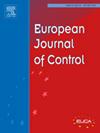平移耦合双柔性梁系统的滑模强化学习振动控制
IF 2.6
3区 计算机科学
Q2 AUTOMATION & CONTROL SYSTEMS
引用次数: 0
摘要
研究了高非线性强耦合平移双柔性梁系统的耦合振动控制问题。基于有限元法建立了系统的动力学模型,并通过获取系统的实验数据对模型参数进行了辨识。为了克服滑模控制(SMC)的抖振问题,研究了滑模强化学习控制(SMRLC)方法。以滑动面作为状态输入,采用异步优势actor-critic (A3C)算法,通过与环境的反复试错交互,学习最优控制策略,从而获得鲁棒控制性能。利用双柔性梁系统辨识模型对SMRLC方案进行预学习,平衡学习效率和精度,并通过数值仿真进一步验证了预学习SMRLC方法的有效性。搭建了实验装置,进行了前两种弯曲模态的振动控制实验,包括设定点振动控制和梯形轨迹下的同步平移振动控制。将SMRLC与PD控制和SMC控制进行了比较。实验结果表明,所设计的SMRLC方法可以有效地降低控制信号的抖振,抑制双柔性梁系统的大小幅值振动,控制值不存在饱和。本文章由计算机程序翻译,如有差异,请以英文原文为准。

Sliding mode reinforcement learning vibration control of a translational coupled double flexible beam system
The coupled vibration control of a translational double flexible beam system with high nonlinearity and strong coupling is studied. The dynamic model of the system is established based on the finite element method (FEM), and the model parameters are identified by acquiring the experimental data of the system. To overcome the chattering problem of sliding mode control (SMC), a sliding mode reinforcement learning control (SMRLC) method is investigated. Taking the sliding surface as the state input, the asynchronous advantage actor-critic (A3C) algorithm is adopted to learn the optimal control policy through repeated trial and error interaction with the environment, so as to achieve robust control performance. The identification model of the double flexible beam system is used to pre-learn the SMRLC scheme to balance the learning efficiency and precision, and the effectiveness of the pre-learned SMRLC method is further verified by numerical simulation. The experimental setup is constructed, and the vibration control experiments of the first two bending modes are conducted, including set-point vibration control and simultaneous translation and vibration control under trapezoidal trajectory. SMRLC is compared with PD control and SMC. The experimental results demonstrate that the designed SMRLC method can effectively reduce the chattering of control signals and suppress the large and small amplitude vibration of the double flexible beam system, and there is no saturation in the control value.
求助全文
通过发布文献求助,成功后即可免费获取论文全文。
去求助
来源期刊

European Journal of Control
工程技术-自动化与控制系统
CiteScore
5.80
自引率
5.90%
发文量
131
审稿时长
1 months
期刊介绍:
The European Control Association (EUCA) has among its objectives to promote the development of the discipline. Apart from the European Control Conferences, the European Journal of Control is the Association''s main channel for the dissemination of important contributions in the field.
The aim of the Journal is to publish high quality papers on the theory and practice of control and systems engineering.
The scope of the Journal will be wide and cover all aspects of the discipline including methodologies, techniques and applications.
Research in control and systems engineering is necessary to develop new concepts and tools which enhance our understanding and improve our ability to design and implement high performance control systems. Submitted papers should stress the practical motivations and relevance of their results.
The design and implementation of a successful control system requires the use of a range of techniques:
Modelling
Robustness Analysis
Identification
Optimization
Control Law Design
Numerical analysis
Fault Detection, and so on.
 求助内容:
求助内容: 应助结果提醒方式:
应助结果提醒方式:


